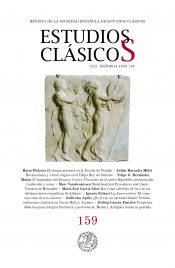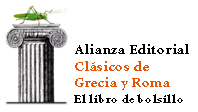METATHEATRICAL PROCEDURES AND COMIC CREATION IN MENANDERProcedimientos metateatrales y creación cómica en Menandro
Marc Vandersmissen
University of Liege | Conservatoire of Bruxelles
https://crb.academia.edu/MarcVandersmissen
https://www.uliege.be/cms/c_9054334/fr/repertoire?uid=U214266
Resumen
The concept of metatheatre is outstanding for the study of ancient theatre, both Greek and Roman. It raises many questions regarding the textual links between the stage and the audience. However, researchers have often opposed the general dramatic action stricto sensu and the metatheatrical speeches, more limited in the plays. In this paper, I will demonstrate that Menander’s theatre, as a whole, is metatheatrical and that the public is entirely part of the dramatic illusion: for the author, the point would not be to propose a universe dissociated from the spectators. There would not be a border between the tiers and the stage made visible for a short while by specific lines (passive assistance vs active comedians). Menander aims to create a fictional space whereby actors and spectators are continuously connected together by a set of interdependent links. By this way, Menander would take all the participants of the show from the extratheatricality to the intratheatricality. These conditions would generate a homogenous group united, during the time of the performance, by its awareness of the theatrical norms.
Palabras clave: Teatro antiguo; Comedia griega; Menandro; Metateatro
Abstract
El concepto de metateatro destaca en el estudio del teatro antiguo, tanto griego como romano. Plantea muchas cuestiones relativas a los vínculos textuales entre la escena y el público. Sin embargo, los investigadores han opuesto a menudo la acción dramática general stricto sensu y los discursos metateatrales, más limitados en las obras. En este trabajo, demostraré que el teatro de Menandro, en su conjunto, es metateatral y que el público forma parte por completo de la ilusión dramática: para el autor, no se trataría de proponer un universo disociado de los espectadores. No habría una frontera entre las gradas y el escenario que se hace visible durante un rato por líneas específicas (asistencia pasiva frente a comediantes activos). Menandro pretende crear un espacio ficticio en el que actores y espectadores estén continuamente conectados entre sí por un conjunto de vínculos interdependientes. De este modo, Menandro llevaría a todos los participantes del espectáculo de la extrateatralidad a la intrateatralidad. Estas condiciones generarían un grupo homogéneo unido, durante el tiempo de la representación, por su conciencia de las normas teatrales.
Keywords: Ancient Theatre; Greek Comedy; Menander; Metatheatre
Referencias bibliográficas
Adrados, F.R. (1975) Festival, Comedy and Tragedy: the Greek Origins of Theatre, Leiden, E.J. Brill.
Andews, N.E. (2004) “Tragic Re-Presentation and the Semantics of Space in Plautus’ Casina”, Mnemosyne 57, 445-464.
Bain, D. (1977) Actors and Audience: A Study of Asides and Related Conventions in Greek Drama, Oxford, Oxford University Press.
Beroutsos, D.C. (2005) A Commentary on the Aspis of Menander. Part One: Lines 1-298, Göttingen, Vandenhoeck & Ruprecht.
Bierl, A. (2001) Der Chor in der alten Komödie: Ritual und Performativität, Leipzig, De Gruyter.
Brown, P.G. McC. (1987) “Masks, Names and Characters in New Comedy”, Hermes 115, 181-202.
Chantraine, P. (1999) Dictionnaire étymologique de la langue grecque, Paris, Presses Universitaires de France [orig. ed. 1968].
Csapo, E. & Slater, W.J. (1994) The Context of Ancient Drama, Ann Arbor, The University of Michigan Press.
David, I. & Lhostis, N. (2016) (eds) Codes dramaturgiques et normes morales dans la comédie nouvelle de Ménandre et de Plaute, Paris, Éditions de Boccard.
Dedoussi, C. (1995) “Greek Drama and its Spectators: Conventions and Relationships”, en A. Griffiths (ed.) Stage Directions: Essays in Ancient Drama in Honour of E. W. Handley, London, Institute of Classical Studies, 123-132.
Dobrov, G.W. (2001) Figures of Play: Greek Drama and Metafictional Poetics, Oxford, Oxford University Press.
Dupont, F. & Letessier, P. (2011) Le théâtre romain, Paris, Armand Colin.
Gome, A.W. & Sandbach, F.H. (1973), Menander: A Commentary, Oxford, Oxford University Press.
Gutzwiller, K. (2000) “The Tragic Mask of Comedy: Metatheatricality in Menander”, Classical Antiquity 19, 102-137.
Henderson, J.J. (1990) “The Demos and Comic Competition”, en J.J. Winkler & F. I. Zeitlin (eds) Nothing to do with Dionysos? Athenian Drama in Its Social Context, Princeton, Princeton University Press, 217-313.
Handley, E.W. (1965) The Dyskolos of Menander, London, Methuen & Co Ltd.
Jacques, J.-M. (1998) Ménandre, Le Bouclier, t.1, Paris, Les Belles Lettres.
Katsouris, A.G. (1975) Tragic Patterns in Menander, Athens.
Konstan, D. (2014) “Defining the Genre”, en M. Revermann (ed.) The Cambridge Companion to Greek Comedy, Cambridge University Press, 27-42.
Lamagna, M. (1994) Menandro: La Fanciula Tosata. Testo critico, introduzione, traduzione e commentario, Napoli, M. D’Auria Editore.
Lennartz, K. (1999) “‘Metatheatralisches’ in den Epitrepontes: Zu Men. Epitr. V. 362-370”, Göttinger Forum für Altertumswissenschaft 2, 109-114.
Marshall, C. W. (2002) “Chorus, Metatheatre, and Menander, Dyskolos 427-41”, Scholia 11, 3-17.
— (2014) “Dramatic Technique and Athenian Comedy”, en M. Revermann (ed.) The Cambridge Companion to Greek Comedy, Cambridge, Cambridge University Press, 131-146.
Papaioannou, S. (2010) “Postclassical Comedy and The Composition of Roman Comedy”, en S. Papaioannou & A. K. Petrides (eds) New Perspectives On Postclassical Comedy, Cambridge, Cambridge Scholars Publishing, 146-175 .
Sommerstein, A.H. (2013) Menander: Samia, Cambridge, Cambridge University Press, 2013.
Stockert, W. (1997) “Metatheatralisches in Menanders Epitrepontes”, Wiener Studien 110, 5-18.
Stow, H.L. (1936) The Violation of the Dramatic Illusion in the Comedies of Aristophanes, Chicago, Chicago University Press.
Wyles, D. (1991) The Masks of Menander: Sign and Meaning in Greek and Roman Performance, Cambridge, Cambridge University Press.
Wyles, R. (2011) Costume in Greek Tragedy, London, Bristol Classical Press.
Zagagi, N. (1995) The Comedy of Menander: Convention, Variation and Originality, Bloomington, Indiana University Press.
Revista
-
Sobre la revista
Página principal
-
Estatutos
Estatutos de la Revista Estudios Clásicos
-
Código ético
Declaración de buenas prácticas
-
Normas de recepción y envío
Indicaciones para envíos de artículos
-
Equipo editorial
Consejos de redacción y asesor
-
Comité de honor
Comité de honor
Información
-
Para autores
Publicar con nosotros
-
Para evaluadores
Normas para evaluar artículos
-
Para bibliotecas
Información bibliográfica
-
Contacto
Cuestiones y preguntas
Publicar en EClás
-
Envío de originales
Artículos y reseñas
-
Normas de publicación
Descarga normas en PDF
-
Estilo CSL EClás
Estilo CSL EClás
-
Índices de calidad
Bases de datos e impactos


 c/ Serrano, 107
c/ Serrano, 107